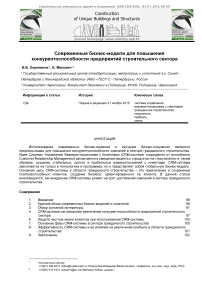Современные бизнес-модели для повышения конкурентоспособности предприятий строительного сектора
Автор: Окрепилов Владимир Валентинович, Мелович Бобан
Журнал: Строительство уникальных зданий и сооружений @unistroy
Статья в выпуске: 10 (37), 2015 года.
Бесплатный доступ
Использование современных бизнес-моделей и изучение бизнес-окружения являются предпосылками для повышения конкурентоспособности компаний в секторе гражданского строительства. Идея Системы Управления Взаимоотношениями с Клиентами (CRM-система, сокращенно от английского Customer Relationship Management) заключается в смещении акцента с «продукта» на «покупателя» и, таким образом, создании стабильных, долгих и прибыльных взаимоотношений с клиентами. CRM-система заключается не только в технологиях и программах, но и представляет собой глобальную бизнес-модель. Основная цель CRM-системы в области гражданского строительства - это привлечение и сохранение платежеспособных клиентов, создание бизнеса, ориентированного на клиента. В данной статье анализируется, как внедрение CRM-системы влияет на рост достижений компаний в секторе гражданского строительства.
Система управления взаимоотношениями с клиентами, гражданское строительство, покупатель, прибыль, успех
Короткий адрес: https://sciup.org/14322188
IDR: 14322188
Список литературы Современные бизнес-модели для повышения конкурентоспособности предприятий строительного сектора
- Vranešević, T. Managing clients' satisfaction. Graficki zavod Hrvatske (2000) Zagreb, 273 p.
- Gholami H., Zameri M., Saman M., Sharif S., Zakuan N. A CRM Strategic Leadership Towards Sustainable Development in Student Relationship Management: SD in Higher Education (2015) Procedia Manufacturing, Vol. 2, pp 51-60.
- Khodakarami F., Yolande E. Chan. Exploring the role of customer relationship management (CRM) systems in customer knowledge creation (2014) Information & Management, Vol. 51, Issue 1, pp 27-42.
- Tohidi H., Mehdi Jabbari M. CRM in Organizational Structure Design (2012) Procedia Technology, Vol. 1, pp 579-582.
- Jocovic, M., Melovic, B., Vatin, N., Murgul, V. Modern business strategy Customer Relationship Management in the area of civil engineering (2014) Applied Mechanics and Materials Vol. 678 pp 644-647
- Ćetković, J., Knežević, M., Žarković, M., Murgul, V., Vatin, N. Development and competitiveness improvement of the construction sector in Montenegro (2014) Applied Mechanics and Materials. Vol. 638-640, pp 2465-2470.
- Usanova, K., Rechinsky, A., Vatin, N. Academy of construction for university applicants as a tool of university online marketing (2014) Applied Mechanics and Materials, 635-637, pp. 2090-2094.
- Vatin, N., Gamayunova, O., Nemova, D. Analysis of the real estate market of St. Petersburg (2014) Applied Mechanics and Materials, 638-640, pp. 2460-2464.
- Garrido-Moreno A., Lockett N., García-Morales V. Paving the way for CRM success: The mediating role of knowledge management and organizational commitment (2014) Information & Management, Vol. 51, Issue 8, pp 1031-1042
- Steel M., Dubelaar C., Michael T. Ewing. Developing customised CRM projects: The role of industry norms, organisational context and customer expectations on CRM implementation (2013) Industrial Marketing Management, Vol. 42, Issue 8, pp 1328-1344.
- James W. Peltier, Zahay D, Donald R. Lehmann. Organizational Learning and CRM Success: A Model for Linking Organizational Practices, Customer Data Quality, and Performance (2013) Journal of Interactive Marketing, Vol. 27, Issue 1, pp 1-13
- Femina Bahari T., Sudheep Elayidom M. An Efficient CRM-Data Mining Framework for the Prediction of Customer Behaviour (2015) Procedia Computer Science, Vol. 46, pp 725-731
- David J. Finnegan, Wendy L. Currie. A multi-layered approach to CRM implementation: An integration perspective (2010) European Management Journal, Vol. 28, Issue 2, pp 153-167
- Kubina M., Lendel V. Successful Application of Social CRM in The Company (2015) Procedia Economics and Finance, Vol. 23, pp. 1190-1194.
- Winer, R. Customer Relationship Management: A Framework, Research Directions, and the Future (2001) Haas School of Business, University of California at Berkeley, 274 p.
- Stanković, Lj., Radenković-Jocić, D., Đukić, S. Improving business competitiveness (2005) Faculty of Economics, Niš, 263 p.
- Vasković, V. Electronic business and Internet marketing (2008) Belgrade business school, Beograd.
- Muller, J., Srića, V. CRM (2005) ZT Zagraf, Zagreb, 372 p.
- Lovreta, S., Berman, B., Petković, G., Veljković, S., Crnković, J., Bogetić, Z. Management of relationships with customers (2010) Belgrade: Faculty of Economics, 163 p.
- Ćetković, J., Knežević, M., Ivanišević, N., Rutešić, S. Mark of the investment projects in civil engineering with the special retrospection to the economical-financial mark of the project (2010) Journal of Spatial and Landscape Planning Vol. 2, Issue 1, pp. 47-55.
- Yun E. Zeng, H. Joseph Wen, David C. Yen, "Customer relationship management (CRM) in business-to-business (B2B) e-commerce", Emerald 11, (2003). pp. 23-57.
- Reinartz, Werner, Manfred Krafft, and Wayne D. Hoyer (2004), "The Customer Relationship Management Process: Its Measurement and Impact on Performance", Journal of Marketing Research, 41 (August), 293-305.
- Davenport, T.H., Harris, J.G., Kohli, A.K. (2001), "How do they know their customers so well?", MIT Sloan Management Review, Vol. 42 No.2, pp.63-73.
- Balaram, A., Adhikari, B. (2010), Managing Customer Relationships in Service Organizations. Administration and Management Review, 21(2), 65-78.
- David Jacoby (2009), Guide to Supply Chain Management: How Getting it Right Boosts Corporate Performance (The Economist Books), Bloomberg Press; 1st edition, ISBN 978-1576603451, 328 p.
- David Blanchard (2010), Supply Chain Management Best Practices, 2nd. Edition, John Wiley & Sons, ISBN 9780470531884, 442 p.
- David S. Linthicum (1999) Enterprise Application Integration, Publisher: Addison Wesley, ISBN: 0-201-61583-5, 400 p.
- Coker, Frank (2014). Pulse: Understanding the Vital Signs of Your Business. Ambient Light Publishing. pp. 41-42.
- Jeanne W. Ross, Peter Weill, David C. Robertson (2006) Enterprise Architecture As Strategy, p. 117 ISBN 1-59139-839-8, 223 p.


